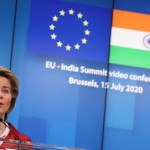Is the Indo-Pacific a new geographic region, a geopolitical concept, a strategy, or a policy? Perhaps the best assessment is that it is a mixture of it all. It is a relatively new geopolitical doctrine based on the late Japanese Prime Minister Shinzo Abe’s definition of the region as the confluence of the Pacific and Indian Oceans and the lands washed by their waters. It is a prudent substitute for the older, more limiting term – ‘Asia-Pacific’. The newer doctrine argues that the twin issues of security and development are deeply intertwined in this region, a fact that demands an integrated, rather than the compartmentalised, approach of the past.
The Indo-Pacific is a connected and seamless space that hosts 64% of the global population, contributes over 60% of the world’s GDP, and about half of global trade passes through the maritime trade routes in this region. As External Affairs Minister S. Jaishankar explained in his famous address at Chulalongkorn University in August 2022, the emergence of the Indo-Pacific has resulted from the diversification of power distribution in the past two decades. “The re-positioning of the US, the rise of China, as also of India, the greater external engagement of Japan and Australia, the wider interests of South Korea and indeed, the broader outlook of the ASEAN itself have all contributed to this transformation,” he said the term ‘Indo-Pacific’ become fashionable a decade ago. The Indian Council of World Affairs (ICWA) played a seminal role in its development by hosting one of the earliest international conferences on this subject in March 2013. Since then, the concept has developed/
The government of India defines the Indo-Pacific as stretching from the eastern shores of Africa to the western shores of America. It strives for a “free, open, inclusive, peaceful, and prosperous region, one which is built on a rules-based international order sustainable and transparent infrastructure investment, freedom of navigation and over-flight, unimpeded lawful commerce, mutual respect for sovereignty, peaceful resolution of disputes, as well as equality of all nations.”
India’s Indo-Pacific strategy stems from the Look and Act East Policy, the vision of SAGAR (Security and Growth for All in the Region), and is instrumentalised by the Indo-Pacific Oceans’ Initiative (IPOI) pursued since November 2019.
A critical stage was reached with the bloody clash between the Indian and Chinese troops in the Galwan Valley in June 2020. The continuing military standoff and the diplomatic impasse in resolving the border issues, both immediate and long-term, have ensured that India’s hard-nosed realism on China, backed by military preparedness, will remain unchanged. This drives New Delhi’s endeavour to strengthen the Quad comprising the US, India, Japan, and Australia in all relevant domains: maritime security, critical and emerging technologies, trade and economic cooperation, and people-to-people ties. This is set to continue, along with serious endeavours to deepen mutual understanding and cooperation with ASEAN and other regional players who too have suffered from China’s heavy-handed approach towards them.
The EU’s thinking, policy, and actions have been in the process of gradual evolution in the past five years. Both the strategies of individual nations – France, Germany, Netherlands – and of the EU need to be studied carefully. Should we prefer a wider approach of examination, then we may also consider the policy pronouncements of the UK and NATO regarding this region. Viewed from the Indian perspective, Europe’s growing interest in the region is most welcome. The expansion of economic and technological cooperation between the EU and India is mutually beneficial.
However, European experts need to explain the ambivalence in the EU’s China policy. The ambiguity in policy, the desire of most European states to stay neutral in the U.S.-China rivalry, and the inclination to prioritise trade over security and strategy may not work in the long term. The way out for the EU is to raise the profile of its relations in the region and to take a clear position on the China question. Strategies must also take into account the shifting power equations in the region.
An essay titled European Perceptions of the Indo-Pacific: A Closer Examination, authored by Frederic Gare and Manisha Reuter and published by the European Council on Foreign Relations in September 2021, provides valuable insights for this discussion.
Finally, through an in-depth dialogue on the topics identified above, there must be an effort to find answers to the question of what challenges and opportunities exist for all relevant players in the Indo-Pacific. Strategies and policies must account for and adapt to the changing power equations in the region.
This question is especially important at present, as the two regions – Europe and West Asia – grapple with military conflicts. And here is a teaser question: have the Russia-Ukraine and Israel-Hamas wars reduced the salience of the Indo-Pacific in global geopolitics?
Rajiv Bhatia is Distinguished Fellow, Foreign Policy Studies, and a former ambassador.
This article is based on the keynote address delivered by the author at the International Conference on India and the EU in the Indo-Pacific: Strategy, Opportunities and Challenges, organised by the Manipal Academy of Higher Education, Karnataka, and Konrad Adenauer Stiftung-India on November 3-4, 2023.


